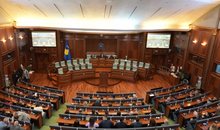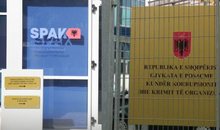
 Flash News
Flash News
The body of a 29-year-old man in Klos is found after 6 days
Arrested a few meters from SPAK, the Special Prosecution seeks 17 years in prison for the drug 'boss'
Giro D'Italia starts today, here are the road axes that will be blocked in Tirana from 13:00-18:00
Who is the new Pope?
Pope Leo XIV greets the faithful for the first time in St. Peter's Square
Banks' exposure to the property market increases, 46% of loans secured by real estate

The coverage of bank loans with collateral increased further last year. Bank of Albania data shows that at the end of 2024, 76% of loans were covered by collateral, up from 75% a year earlier.
The most widely used type of collateral by banks continues to be real estate. Properties cover 61% of collateralized loans and 46% of total loan outstanding.
According to the Bank of Albania, the stock of loans collateralized with real estate has expanded by 9% compared to a year earlier, as a result of the increase in loans collateralized with residential real estate.
The high level of collateralization of loans with real estate makes the banking sector exposed to developments in the property market. A possible decline in property prices would create increased risks for the health of the banking sector in the country.
To this end, the Bank of Albania has been collecting more detailed data since last year, based on the regulation “On reporting data, identifying and monitoring indicators on lending and investments in real estate”. It aims to improve the data to be collected by banks on their exposure to the real estate market.
Two days ago, the Supervisory Council of the Bank of Albania imposed some restrictive measures on bank loans for homes. According to the decision, the ceiling loan-to-value ratio in Lek will be 85% for the first home and 80% for the second home, while in foreign currency 75% for the first home and 70% for the second home.
Meanwhile, due to the rapid growth of real estate lending, the Bank of Albania applied a special capital surcharge to the banking sector for the first time last year. The countercyclical capital surcharge was first set in June at 0.25% (to be implemented from 30 June 2025) and increased in December to 0.5% (to be implemented from 31 December 2025).
The application of a countercyclical capital buffer is provided for in the 2018 regulation “On Macroprudential Capital Buffers.” Such a buffer is intended to slow down lending if the central bank assesses that growth is occurring at an excessively rapid pace.
In the analysis of the Bank of Albania, for several quarters, the Albanian economy has been experiencing a positive financial cycle based on accelerated growth in bank credit, and such periods are associated with good levels of financial performance for real economy agents and the financial system.
However, according to the Bank of Albania, these periods are also associated with the onset of certain risks, which may be related to a decline in lending standards, an increase in its concentration levels in certain sectors or markets, and an increase in debt levels for real economy agents beyond healthy levels.
These situations, if allowed to develop, could make the economy and the financial system more vulnerable to various shocks, thus undermining financial stability. For these reasons, in these cases, it is suggested to use macroprudential instruments that act countercyclically and prevent the uncontrolled development of these risks./MONITOR
Latest news


Is Rama ready to become the next Hoxha?
2025-05-09 13:50:12
Election materials arrive in Kukës, Has and Tropoja
2025-05-09 13:30:20
Electoral flight to Vlora
2025-05-09 13:18:04

IdentiTek offices open on Saturdays
2025-05-09 13:03:13
Will artificial intelligence help us talk to animals?
2025-05-09 12:55:58



Rama's fourth act: between Brussels and the Mafia
2025-05-09 12:12:47
The body of a 29-year-old man in Klos is found after 6 days
2025-05-09 12:01:27
Berisha: After May 12, this opposition will become the majority in Albania
2025-05-09 11:52:37
Leo XIV celebrates his first Mass as Pope
2025-05-09 11:42:34

Spaho denounces: SP candidate in Pogradec gives 100 thousand lek for the vote
2025-05-09 11:27:26
Mustafaj: Proud of the worthy campaign of the DP
2025-05-09 11:22:20
Constitution fails again, Kosovo still without a new Assembly
2025-05-09 11:06:55





"Votes have no price", the US embassy in Tirana 'slaps' Rama
2025-05-09 10:06:49

Two young men arrested for supplying criminal groups with firearms
2025-05-09 09:45:19







Foreign exchange/ How much foreign currencies are bought and sold today
2025-05-09 08:19:18
The gift that Berisha gave to Rama 'live'
2025-05-09 08:13:51
3 signs that show you are spiritually protected
2025-05-09 08:05:39

Bars can't hold back anymore, start increasing coffee prices, 4.7% more in April
2025-05-09 07:46:49

Horoscope, what do the stars have in store for you today?
2025-05-09 07:22:06
Unstable weather, afternoon brings rain
2025-05-09 07:01:29
Morning Post/ In 2 lines: What mattered yesterday in Albania
2025-05-09 06:45:46

How did LaCivita change the DP campaign? Berisha: He studied the opponent
2025-05-08 22:49:51

David defeats Goliath
2025-05-08 22:15:50

Journalist: There are SPAK infiltrators in party headquarters
2025-05-08 21:55:15
Who is the new Pope?
2025-05-08 21:48:13
Berisha finally reveals when he will retire from politics
2025-05-08 21:33:46


LaCivita in Lezha: Albanians will fire Edi Rama from his job
2025-05-08 21:11:20


Berisha: LaCivita chose us because he believes in Reagan's program
2025-05-08 20:48:40
He rejected America to serve Pogradec, Genti Çela tells about life in "Elevate"
2025-05-08 20:26:28




Pope Leo XIV greets the faithful for the first time in St. Peter's Square
2025-05-08 19:29:33




Photo session with LaCivitta in Tirana: For Great Albania
2025-05-08 18:40:18
Source: DASH decision a personal victory for Berisha
2025-05-08 18:30:10
Take off those crazy glasses and see where you've taken him?
2025-05-08 18:02:47
LDK files criminal charges against members of the incumbent Government
2025-05-08 18:02:00







BIRN analysis: Tirana, the determining district for the future majority
2025-05-08 16:04:03




Chris LaCivita's contract with the DP, Berisha: 100% correct and clean
2025-05-08 15:11:11

"These are the peak days", Berisha reveals when he will travel to the USA
2025-05-08 14:45:25


Endless boxes with filled-in ballots, DP demands separation of votes from Greece
2025-05-08 14:11:12


Photo/ Who are the 3 associates of Talo Çela arrested in Dubai?
2025-05-08 13:37:09

Hetimi për krimet zgjedhore, Altin Dumani zbarkon në Prokurorinë e Shkodrës
2025-05-08 13:06:21
DASH paves the way for Berisha, Alizoti: Great news on the eve of Great Albania!
2025-05-08 13:03:48

"Freedom works", DP welcomes the US position
2025-05-08 12:48:07

Black smoke rises from the Sistine Chapel, the Vatican still without a Pope
2025-05-08 12:26:18

